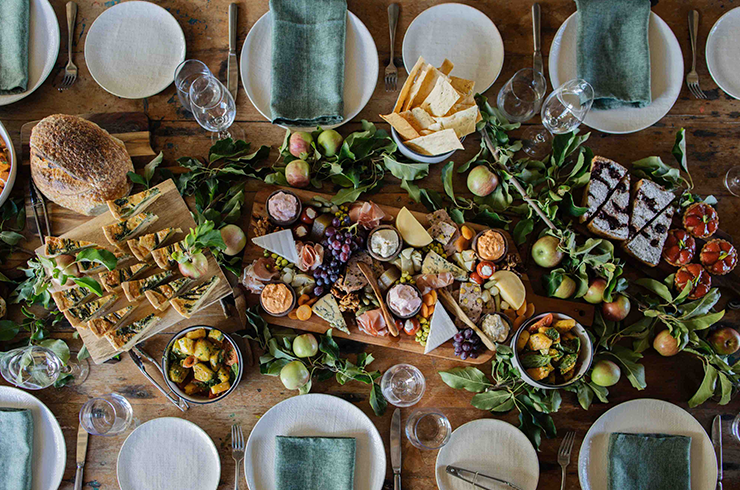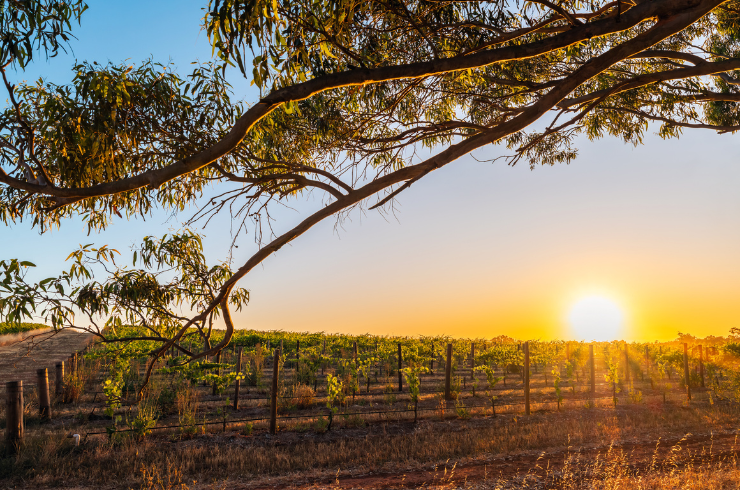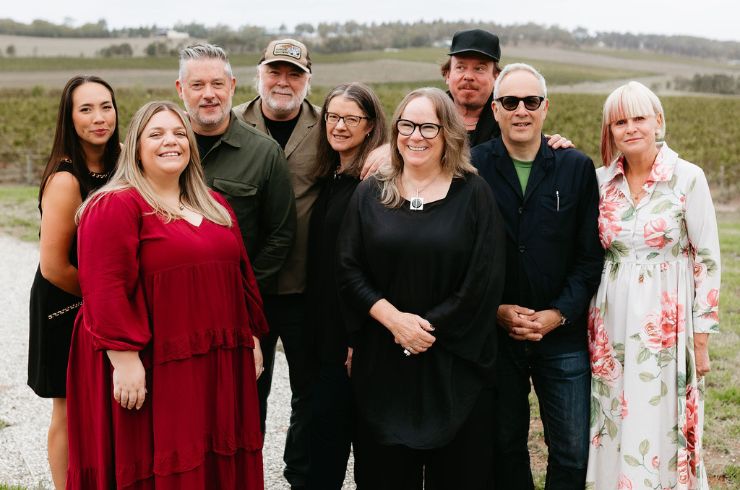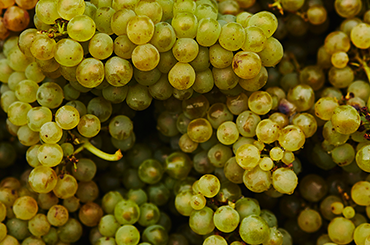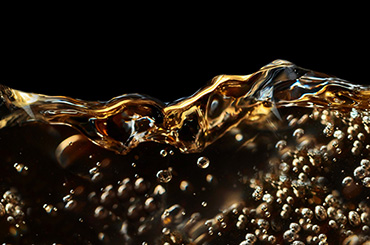During the 2011 vintage, Tasmanian winemaker Jeremy Dineen gave the green light to young visiting Czech winemaker Ondrej Veselev to try his luck with a batch of riesling fruit. “Have a crack,” Jeremy told him, as the grapes started arriving at the Josef Chromy winery outside Launceston. And so he did.
Traditionally, riesling in this country is treated pretty simply: press, neutral yeast to start fermentation and then stainless steel all the way. But this was not the case for Ondrej. With his Czech background, he crushed the grapes (Jeremy has lasting images in his head of the young man “throwing” sulphur wildly at the fruit in the crusher) and left the resulting mess of skins and juice to soak for two hours. With fermentation underway, he pumped 15 per cent of the juice into old oak barrels and the remainder into stainless steel where it finished its maturation.
Ondrej’s aim was to create a wine of texture and breadth, and possibly receive a little kudos from his fellow winemakers. Or at least those not questioning his sanity.
The wine was good, Jeremy remembers, but different. Edgier. It was released as the 2011 OV Riesling and became a favourite of the winery’s founder, Czech-born Josef Chromy. “He often asks if we can make another,” says Jeremy, who already makes five styles.
On the new riesling frontline, borders are few. Czech makers work vintage here, as do Germans, Austrians and Alsatians too. Australian winemakers reciprocate the gesture, spending time overseas, and in the feverish cross-pollination that results, the imagination of the Australian riesling maker takes flight.
That ‘What if?’ question starts to get real. What if we pursue a different riesling personality to the usual cool, pure, linear beauty of Australian tradition? What if we introduce skin contact to release powerful phenolic compounds, a group of flavour chemicals generally considered super important in red wines, but less so in whites? Or what if we ferment in oak barrels? Or, what the heck, let go of everything learnt and embrace a touch of wildness?
In the hands of a younger generation of winemakers, traditional riesling has become funky. A bunch of radical rieslings are even making it onto wine lists and retail shelves, including the surprise packet of Best’s Foudre Ferment Riesling, with its unusual nuttiness, Nick Glaetzer’s stunningly individual Uberblanc, and the rebellious Das Sakrileg Riesling from La Violetta.
Sommelier Leanne Altmann, beverage director for the Andrew McConnell group of restaurants in Melbourne, feels these radical styles are opening the market to new drinkers. “I think this wave of riesling experimentation, and the eye-catching labels that often come with the bottles, has drawn the attention of the next generation of wine lovers,” she says.
We think we know riesling – acid and sugar/sugar and acid – but it’s much more complicated. For one thing, there are lots of phenolics and tannins to be found in the grape’s skin, which some new adopters have embraced. “The Australian Wine and Research Institute did an interesting study years ago looking at chardonnay, viognier and riesling,” says Tasmanian maker Samantha Connew, who is evolving a textural, stylish riesling under her Stargazer label. “Out of them, riesling has the highest natural phenolics. When you look at the German styles, that’s obviously what they are about, but we have talked ourselves into thinking that it was about acid and sugar.”
Having fully embraced riesling phenolics by leaving grape skins in contact with juice, Samantha is now looking to skin-contact fermentations. “I fancy some really good results,” she says. “Skins have so much flavour and you want to extract all of that goodness as much as you can.”
We think we know where the riesling grape grows best in Australia. The Clare and Eden Valleys have the history and runs on the board, but the emergence of other regions has significantly broadened the grape’s repertoire. Look to regions such as Canberra, WA’s Great Southern, Orange in NSW, Coal River Valley and Tamar Valley in Tasmania, and Heathcote in Victoria. “I don’t think we are disrupting the traditional Australian style just yet,” says Hunter Smith of Frankland Estate when asked if the Great Southern region is taking it up to the South Australians. However, Hunter adds that the area – which celebrates 50 years of growing riesling this year, with 150 hectares of it planted – is delivering textural, interesting styles that are “among the country’s best”.
The riesling story in Tasmania is a little shorter, but with 105 hectares in the ground and plantings growing by five per cent annually, it is a riesling region on the rise. If Tassie wine producers appear super-confident, it’s for a reason. Makers such as Bream Creek, Moorilla Estate, Josef Chromy, Holm Oak and Stefano Lubiana proved the state’s potential early on.
Today, with Pooley Wines, Pressing Matters, Glaetzer-Dixon, Bay of Fires and Stargazer among the Tamanian producers taking the lead, the grape moves up a notch in style – with many variations – and class. “It probably won’t happen in my lifetime, but eventually it will be one of the great – if not the greatest – riesling regions in the country,” says Jeremy of Josef Chromy. “As the rest of Australia gets warmer and warmer, and the climate becomes difficult in the Clare and the Eden, I think you will see more producers looking to places like Tassie.”
Many people are excited by the rise in riesling experimentation, but not all. Sydney sommelier Matt Swieboda, the creative force behind wine bars Love, Tilly Devine and Dear Sainte Eloise, is critical of badly made skin-contact rieslings – those that are heavy-handed in winemaking and lacking detail. “I’ve certainly never seen a skinsy expression reach the heights that riesling can achieve in a more traditional context,” he says. However, one good example on his wine lists is the Artesian Lava Riesling 2017 from Good Intentions Wine Co, off the volcanic soils of Mount Gambier.
A maker of some of WA’s finest rieslings, Jeff Burch at Howard Park decries a fundamental fault of rieslings made with skin contact and the like. “A wine should show where it’s from,” he says, arguing that some of the newer styles could be from “anywhere”. “I don’t think that’s authentic.”
Riesling hasn’t been debated with this kind of passion for years, and it will only continue. As to whether what we are seeing is actually new, it is for Australia. “Obviously a lot of the techniques are not new and, in most cases, are the way producers made rieslings for hundreds of years before modern winemaking facilities,” explains Frankland Estate’s Hunter. But they are bringing a breath of fresh air to the way the grape has traditionally been made in Australia.
“Vive la difference, I reckon,” says one of our more exciting riesling makers, Phil Lehmann of the Hesketh Wine Company. He works alongside the greatest Aussie riesling maker of them all, John Vickery of Leo Buring fame, to produce a superb series of Vickery Rieslings. If Phil’s excited, then rest assured there must be something to this riesling revolution.
This feature originally appeared in Halliday magazine. For more in-depth looks at Australian wine trends, subscribe or pick up a copy today.
Traditionally, riesling in this country is treated pretty simply: press, neutral yeast to start fermentation and then stainless steel all the way. But this was not the case for Ondrej. With his Czech background, he crushed the grapes (Jeremy has lasting images in his head of the young man “throwing” sulphur wildly at the fruit in the crusher) and left the resulting mess of skins and juice to soak for two hours. With fermentation underway, he pumped 15 per cent of the juice into old oak barrels and the remainder into stainless steel where it finished its maturation.
Ondrej’s aim was to create a wine of texture and breadth, and possibly receive a little kudos from his fellow winemakers. Or at least those not questioning his sanity.
The wine was good, Jeremy remembers, but different. Edgier. It was released as the 2011 OV Riesling and became a favourite of the winery’s founder, Czech-born Josef Chromy. “He often asks if we can make another,” says Jeremy, who already makes five styles.
On the new riesling frontline, borders are few. Czech makers work vintage here, as do Germans, Austrians and Alsatians too. Australian winemakers reciprocate the gesture, spending time overseas, and in the feverish cross-pollination that results, the imagination of the Australian riesling maker takes flight.
That ‘What if?’ question starts to get real. What if we pursue a different riesling personality to the usual cool, pure, linear beauty of Australian tradition? What if we introduce skin contact to release powerful phenolic compounds, a group of flavour chemicals generally considered super important in red wines, but less so in whites? Or what if we ferment in oak barrels? Or, what the heck, let go of everything learnt and embrace a touch of wildness?
In the hands of a younger generation of winemakers, traditional riesling has become funky. A bunch of radical rieslings are even making it onto wine lists and retail shelves, including the surprise packet of Best’s Foudre Ferment Riesling, with its unusual nuttiness, Nick Glaetzer’s stunningly individual Uberblanc, and the rebellious Das Sakrileg Riesling from La Violetta.
Sommelier Leanne Altmann, beverage director for the Andrew McConnell group of restaurants in Melbourne, feels these radical styles are opening the market to new drinkers. “I think this wave of riesling experimentation, and the eye-catching labels that often come with the bottles, has drawn the attention of the next generation of wine lovers,” she says.
We think we know riesling – acid and sugar/sugar and acid – but it’s much more complicated. For one thing, there are lots of phenolics and tannins to be found in the grape’s skin, which some new adopters have embraced. “The Australian Wine and Research Institute did an interesting study years ago looking at chardonnay, viognier and riesling,” says Tasmanian maker Samantha Connew, who is evolving a textural, stylish riesling under her Stargazer label. “Out of them, riesling has the highest natural phenolics. When you look at the German styles, that’s obviously what they are about, but we have talked ourselves into thinking that it was about acid and sugar.”
Having fully embraced riesling phenolics by leaving grape skins in contact with juice, Samantha is now looking to skin-contact fermentations. “I fancy some really good results,” she says. “Skins have so much flavour and you want to extract all of that goodness as much as you can.”
We think we know where the riesling grape grows best in Australia. The Clare and Eden Valleys have the history and runs on the board, but the emergence of other regions has significantly broadened the grape’s repertoire. Look to regions such as Canberra, WA’s Great Southern, Orange in NSW, Coal River Valley and Tamar Valley in Tasmania, and Heathcote in Victoria. “I don’t think we are disrupting the traditional Australian style just yet,” says Hunter Smith of Frankland Estate when asked if the Great Southern region is taking it up to the South Australians. However, Hunter adds that the area – which celebrates 50 years of growing riesling this year, with 150 hectares of it planted – is delivering textural, interesting styles that are “among the country’s best”.
The riesling story in Tasmania is a little shorter, but with 105 hectares in the ground and plantings growing by five per cent annually, it is a riesling region on the rise. If Tassie wine producers appear super-confident, it’s for a reason. Makers such as Bream Creek, Moorilla Estate, Josef Chromy, Holm Oak and Stefano Lubiana proved the state’s potential early on.
Today, with Pooley Wines, Pressing Matters, Glaetzer-Dixon, Bay of Fires and Stargazer among the Tamanian producers taking the lead, the grape moves up a notch in style – with many variations – and class. “It probably won’t happen in my lifetime, but eventually it will be one of the great – if not the greatest – riesling regions in the country,” says Jeremy of Josef Chromy. “As the rest of Australia gets warmer and warmer, and the climate becomes difficult in the Clare and the Eden, I think you will see more producers looking to places like Tassie.”
Many people are excited by the rise in riesling experimentation, but not all. Sydney sommelier Matt Swieboda, the creative force behind wine bars Love, Tilly Devine and Dear Sainte Eloise, is critical of badly made skin-contact rieslings – those that are heavy-handed in winemaking and lacking detail. “I’ve certainly never seen a skinsy expression reach the heights that riesling can achieve in a more traditional context,” he says. However, one good example on his wine lists is the Artesian Lava Riesling 2017 from Good Intentions Wine Co, off the volcanic soils of Mount Gambier.
A maker of some of WA’s finest rieslings, Jeff Burch at Howard Park decries a fundamental fault of rieslings made with skin contact and the like. “A wine should show where it’s from,” he says, arguing that some of the newer styles could be from “anywhere”. “I don’t think that’s authentic.”
Riesling hasn’t been debated with this kind of passion for years, and it will only continue. As to whether what we are seeing is actually new, it is for Australia. “Obviously a lot of the techniques are not new and, in most cases, are the way producers made rieslings for hundreds of years before modern winemaking facilities,” explains Frankland Estate’s Hunter. But they are bringing a breath of fresh air to the way the grape has traditionally been made in Australia.
“Vive la difference, I reckon,” says one of our more exciting riesling makers, Phil Lehmann of the Hesketh Wine Company. He works alongside the greatest Aussie riesling maker of them all, John Vickery of Leo Buring fame, to produce a superb series of Vickery Rieslings. If Phil’s excited, then rest assured there must be something to this riesling revolution.
This feature originally appeared in Halliday magazine. For more in-depth looks at Australian wine trends, subscribe or pick up a copy today.
Latest Articles
-
Win
Win a stunning collection of Plumm glassware and wine, valued at over $500
1 day ago -
Wine Lists
Top Christmas wines under $30 (and five worth splurging on)
2 days ago -
Wine Lists
Why you should drink Australian this festive season (and 80 of our best wines to try)
2 days ago -
From the tasting team
The Aussie wines the Halliday Tasting Team will be opening this festive season
2 days ago

